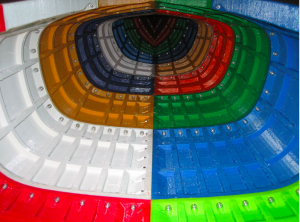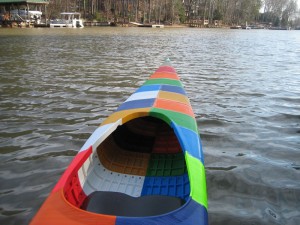In the ever changing world of 3D printing one concept is constantly heard: the only limit to what you can create is your imagination. That implies that all other limitations, such as size, shape, practical use and materials, are just imaginary limits that we create ourselves. Jim Smith, a 3D Systems engineer, maker and founder of the Grass Roots Engineering blog took this concept quite literally and simply pushed the limits a little farther away. About 5.08 meters (5 ft 8in) farther away as that is the size of the first fully 3D printed kayak he created with about $500 worth of material.
The 3D printed kayak is made of ABS plastic, machine screws, brass threaded inserts and a little silicone caulk in between parts for water tightness. As Jim says: “That’s it. And it Floats” And he can kayak around in it. Of course that is not entirely “it”. 3D printing something that large is not something anyone can do and no one said that pushing the limits of imagination does not take a lot of work.
To make the kayak, Jim built his own large volume FFF 3D printer and printed the parts inside a heated chamber so that the ABS would not warp, crack or deform. In total there are 28 3D printed (very colourful) parts for a design inspired by the Siskiwit Bay kayak by Bryan Hansel but heavily modified for 3D printability. For macroscopic practical objects, resolution is not a big issue so the parts were printed with a layer resolution of .65 mm, which allowed him to save on time and materials. The design also made room for cameras at the bow and stern, as well as handles and space for future add ons.
As mentioned previously, the kayak measures 5.08 meters in length — it’s worth repeating. Its width is 0.52 meters and its total weight is 29.29 Kg (of which 26.48 Kg is the weight of the 3D printed ABS plastic parts. Total print time: 1012.65 hours. That is 42.19 days, so basically a month and a half. It sure took a lot longer than ordering it from eBay, but try to make your very first kayak at home using traditional tools. My guess is that it would take you quite a bit more. If you are a maker (and probably even if you are not) you will likely find the video below rather inspiring.






